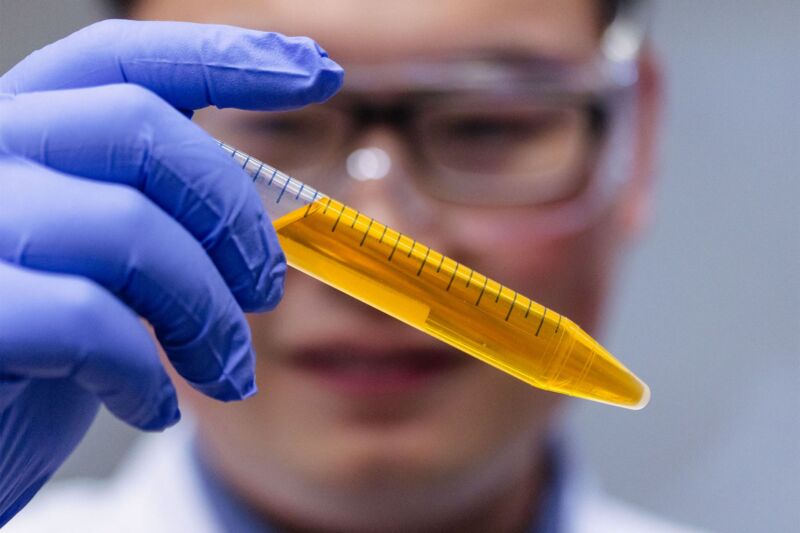Under the skin —
Matching refractive indexes lets some wavelengths pass cleanly through the skin.

Enlarge / Zihao Ou, who helped develop this solution, holds a tube of it.
One key challenge in medical imaging is to look past skin and other tissue that are opaque to see internal organs and structures. This is the reason we need things like ultrasonography, magnetic resonance, or X-rays. There are chemical clearing agents that can make tissue transparent, like acrylamide or tetrahydrofuran, but they are almost never used in living organisms because they’re either highly toxic or can dissolve away essential biomolecules.
But now, a team of Stanford University scientists has finally found an agent that can reversibly make skin transparent without damaging it. This agent was tartrazine, a popular yellow-orange food dye called FD&C Yellow 5 that is notably used for coloring Doritos.
Playing with light
We can’t see through the skin because it is a complex tissue comprising aqueous-based components such as cell interiors and other fluids, as well as protein and lipids. The refractive index is a value that indicates how much light slows down (on average, of course) while going through a material compared to going through a vacuum. The refractive index of those aqueous components is low, while the refractive index of the proteins and lipids is high. As a result, light traveling through skin constantly bends as it endlessly crosses the boundary between high and low refractive index materials.
This scatters the light—once it penetrates the skin, it never gets back. What we see is just the light that bounces off the skin’s surface. The trick to making things transparent is mostly about making their refractive index uniform, so light, or at least some part of the spectrum, doesn’t bend all the time and doesn’t get scattered. This is exactly where the Doritos dye came in.
“The most surprising part of this study is that we usually expect dye molecules to make things less transparent,” says Guosong Hong, an assistant professor of materials science and engineering at Stanford and senior author of the paper. “For example, if you mix blue pen ink in water, the more ink you add, the less light can pass through the water. However, in our experiment, when we dissolve tartrazine in an opaque material like muscle or skin, which normally scatters light, the more tartrazine we add, the clearer the material becomes. This goes against what we typically expect with dyes.”
Transparency lotion
Hong’s team simply dissolved the dye in an aqueous solution and created a transparency-inducing lotion of sorts. It worked, because the dye reduced the difference in refractive index between water and lipids in the skin. Then the team started massaging it gently into a bit of polymer gel that emulated the light-scattering properties of tissue. From there, they moved to thinly sliced chicken breasts and to live mice.
The “transparency lotion” needed just a few minutes to start working when applied to a mouse’s skin. Massaged into a shaven scalp, it lets the scientists see the cerebral blood vessels with laser speckle contrast imaging, a technique that normally requires removal of the scalp to work. When applied to the mouse’s abdomen, it made all the internal organs, including the liver, bladder, and small intestine, visible to the naked eye. All that was needed to reverse the effect and make the skin opaque again was washing the lotion off with water.
There were some problems, though. One of them was that tartrazine absorbed most light at wavelengths around 257 and 428 nanometers, which let us see shades of violet and blue. On the other hand, it had minimal absorption above 600 nanometers, which meant that the transparent skin tinted everything red. The second issue was the depth of penetration. The lotion worked well only at spots where the skin was thin, and couldn’t penetrate deep enough where the skin was thicker.
Finally, its formulation was not universal. It relied on finding a chemical that could match the refractive index of lipids when dissolved in water, but the exact composition of the lotion was determined through trial and error. If there’s a lot of mouse-to-mouse variation, it might make it hard to come up with a one-size-fits-all solution.
Tattoos and needles
The problem of penetrating deeper into thick skin was partially solved by making the application a bit more painful. “Using microneedle patch applicators or subcutaneous injections could help deliver the molecules through thicker layers of skin,” Hong explains. The red tint issue, he suggested, might be handled by testing different dyes. “The research in my lab is currently focused on identifying molecules with sharp absorption in the near-ultraviolet region, minimizing spectral tailing into the visible range to ensure tissue transparency without the presence of a red tone,” Hong said.
“This study has only been conducted on animals. However, if the same technique could be applied to humans, it could offer a variety of benefits in biology, diagnostics, and even cosmetics,” Hong suggests. The benefits he is focusing on include evaluating deep-seated tumors without relying on biopsies, making blood tests less stressful by making locating the veins easier, and even things like improved laser tattoo removals by allowing the pigment beneath the skin to be targeted precisely.
But there is some bad news. Even though the FD&C Yellow 5 dye is widely available, replicating Hong’s results at home and making the transparency lotion on your own is not the brightest idea. “We strongly discourage attempting this on the human skin, as the toxicology of dye molecules in humans, particularly when applied topically, has not been fully evaluated,” Hong says.
And, in the end, it might not even work. “The human skin is significantly thicker than mouse skin, with the stratum corneum, the outermost layer of the epidermis, serving as a substantial barrier that prevents effective delivery of molecules into the dermis,” Hong explains
Science, 2024. DOI: 10.1126/science.adm6869